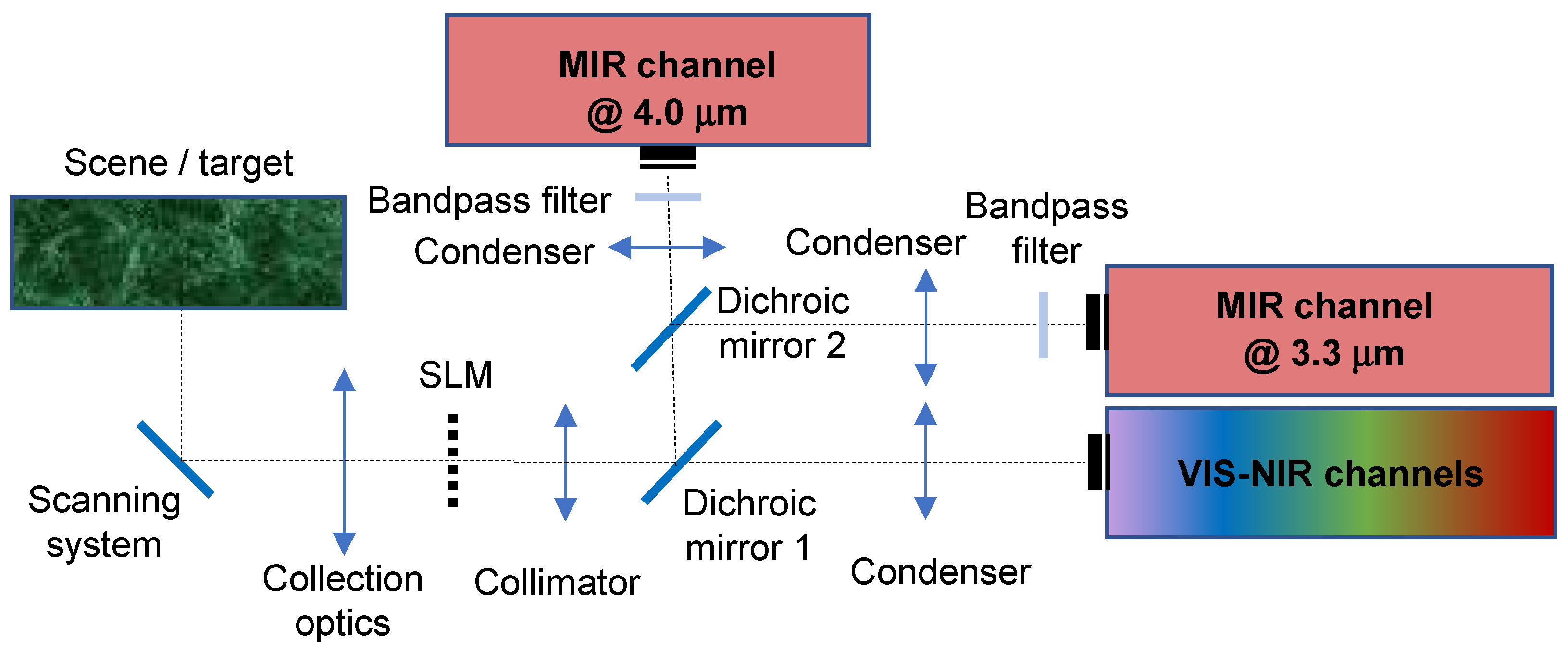Designing a Compressive Sensing Demonstrator of an Earth Observation Payload in the Visible and Medium Infrared: Instrumental Concept and Main Features †
Abstract
:1. Introduction
2. Compressive Sensing and Relevant Instrumental Concept
- Collection optics, which is used to collect the light coming from the target;
- Spatial Light Modulator (SLM), which physically implements the scalar product between the coding mask applied to the SLM and the image focused by the collection optics on the SLM plane;
- Condenser, which implements the integration;
- Single-element detector, which is used to acquire the signal.
3. The SURPRISE Demonstrator
4. Image Reconstruction
5. Conclusions
Funding
Institutional Review Board Statement
Informed Consent Statement
Conflicts of Interest
References
- Candes, E.J.; Wakin, M.B. An introduction to compressive sampling. IEEE Signal Process. Mag. 2008, 25, 21–30. [Google Scholar] [CrossRef]
- Duarte, M.F.; Davenport, M.A.; Takhar, D.; Laska, J.N.; Sun, T.; Kelly, K.F.; Baraniuk, R.G. Single-pixel imaging via compressive sensing. IEEE Trans. Signal Process. 2008, 25, 83–91. [Google Scholar] [CrossRef] [Green Version]
- Mahalanobis, A.; Shilling, R.; Murphy, R.; Muise, R. Recent results of medium wave infrared compressive sensing. Appl. Opt. 2014, 53, 8060–8070. [Google Scholar] [CrossRef] [PubMed]
- Barducci, A.; Coluccia, G.; Guzzi, D.; Lastri, C.; Magli, E.; Raimondi, V. Algorithms and prototyping of a compressive hyperspectral imager. In Compressive Sensing of Earth Observations; CRC Press: Boca Raton, FL, USA, 2017; Chapter 15; pp. 329–350. [Google Scholar]
- Coluccia, G.; Lastri, C.; Guzzi, D.; Magli, E.; Nardino, V.; Palombi, L.; Pippi, I.; Raimondi, V.; Ravazzi, C.; Garoi, F.; et al. Optical Compressive Imaging Technologies for Space Big Data. IEEE Trans. Big Data 2020, 6, 430–442. [Google Scholar] [CrossRef]
- The SURPRISE Project. Available online: http://www.h2020surprise.eu/ (accessed on 23 August 2021).
- Magli, E.; Bianchi, T.; Guzzi, D.; Lastri, C.; Nardino, V.; Palombi, L.; Raimondi, V.; Taricco, D.; Valsesia, D. Compressive imaging and deep learning based image reconstruction methods in the “SURPRISE” EU project. In Proceedings of the European Workshop on On-Board Data Processing (OBDP2021), Online Event. 14–17 June 2021. [Google Scholar]
- Zhang, J.; Ghanem, B. ISTA-Net: Interpretable Optimization-Inspired Deep Network for Image Compressive Sensing. In Proceedings of the 2018 IEEE/CVF Conference on Computer Vision and Pattern Recognition, Salt Lake City, UT, USA, 18–22 June 2018. [Google Scholar]

Publisher’s Note: MDPI stays neutral with regard to jurisdictional claims in published maps and institutional affiliations. |
© 2021 by the authors. Licensee MDPI, Basel, Switzerland. This article is an open access article distributed under the terms and conditions of the Creative Commons Attribution (CC BY) license (https://creativecommons.org/licenses/by/4.0/).
Share and Cite
Raimondi, V.; Acampora, L.; Baldi, M.; Berndt, D.; Bianchi, T.; Borrelli, D.; Corti, C.; Corti, F.; Corti, M.; Cox, N.; et al. Designing a Compressive Sensing Demonstrator of an Earth Observation Payload in the Visible and Medium Infrared: Instrumental Concept and Main Features. Eng. Proc. 2021, 8, 27. https://doi.org/10.3390/engproc2021008027
Raimondi V, Acampora L, Baldi M, Berndt D, Bianchi T, Borrelli D, Corti C, Corti F, Corti M, Cox N, et al. Designing a Compressive Sensing Demonstrator of an Earth Observation Payload in the Visible and Medium Infrared: Instrumental Concept and Main Features. Engineering Proceedings. 2021; 8(1):27. https://doi.org/10.3390/engproc2021008027
Chicago/Turabian StyleRaimondi, Valentina, Luigi Acampora, Massimo Baldi, Dirk Berndt, Tiziano Bianchi, Donato Borrelli, Chiara Corti, Francesco Corti, Marco Corti, Nick Cox, and et al. 2021. "Designing a Compressive Sensing Demonstrator of an Earth Observation Payload in the Visible and Medium Infrared: Instrumental Concept and Main Features" Engineering Proceedings 8, no. 1: 27. https://doi.org/10.3390/engproc2021008027
APA StyleRaimondi, V., Acampora, L., Baldi, M., Berndt, D., Bianchi, T., Borrelli, D., Corti, C., Corti, F., Corti, M., Cox, N., Dauderstädt, U. A., Dürr, P., Fruchi, A., González, S. F., Guzzi, D., Kunze, D., Labate, D., Lamquin, N., Lastri, C., ... Wagner, M. (2021). Designing a Compressive Sensing Demonstrator of an Earth Observation Payload in the Visible and Medium Infrared: Instrumental Concept and Main Features. Engineering Proceedings, 8(1), 27. https://doi.org/10.3390/engproc2021008027






